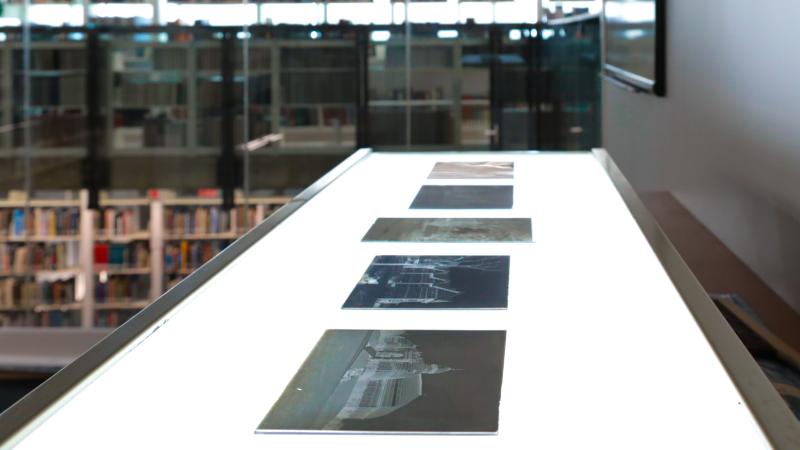Photos Reveal Architecture Student’s View from 1918
The new archival acquisitions show a campus and curriculum at once different and familiar.

Photos Reveal Architecture Student’s View from 1918
In November 2021, the Knowlton School Archives welcomed a collection of 1918 campus photography from donor Larry McCulloch of Colorado, who found the pieces among his family’s possessions. Even though the materials are few in quantity—just five pieces comprise the collection, each in their original envelopes—they are remarkable because of their format, age, condition, and provenance. The photos’ subjects are all buildings from Ohio State’s campus and elsewhere in Columbus, including Orton Hall, the Armory (demolished in 1959), Oxley Hall, Derby Hall (then called the Chemistry Building), and the Franklin Park Conservatory. The new collection represents an illuminating addition to the Archives’ record of both the history of Columbus’ cityscape and the character of the School’s historical curricula.
Each photo in this collection is a glass plate negative, a typical material and exposure process for photographers in 1918. In this case, the apparent photographer was a student of Ohio State’s School of Architecture named Homer D. Lytle, whose signature can be seen on the photo of Orton Hall. When he took these photos in spring 1918, Lytle would have studied in Brown Hall (demolished in 2009) more than eight decades prior to Knowlton Hall’s groundbreaking. Based on evidence from the envelopes printed with rubrics and grade reports, Lytle created these glass plate negatives as part of a Department of Architecture course assignment to practice his technical ability in photography. Because glass plates, also called gelatin dry plates, were almost entirely replaced by roll film negatives in the 1920s and 1930s, these pieces are likely some of the final uses of this technology in Ohio State’s Architecture curriculum. Though not the last time that representation was a feature of the curriculum. Even as technology has changed, representation has remained a central part of the curriculum at Knowlton. Glass plate negatives gave way to film photography and eventually to software, drones, and robots.
The plates will be preserved as part of the Knowlton School Archives’ collections, which are accessible to the public. Digital facsimiles of the photographs and their accompanying reports are available to the public on the Knowlton Digital Library’s website.

Armory
The imposing facade of the Armory’s south corner was captured only 20 years after it was constructed on Ohio State’s campus. In fact, it wasn’t an armory at all but only attracted the nickname because of that fortified facade, its academic tenant the Department of Military Science, and the fact that the United States Army took over the building in 1918 to lodge soldiers. The multipurpose complex, which once hosted Ohio State’s basketball games and contained physical recreation facilities, could have housed Army soldiers when this photo was taken. The university eventually demolished the building in 1959 after a fire severely damaged it the previous year. Peter Eisenman’s Wexner Center for the Arts stands in its place and alludes to its predecessor in a playful outline of the previous building’s facade.

Orton Hall
The trees populating this photo of the western side of Orton Hall were not crisply rendered on a windy day as they might have been with later camera technology. Instead, this plate’s accompanying report states that the camera shutter was open for three seconds, long enough to cause the spring leaves to smear blurry clouds on Lytle’s negative. One hundred years of changes are also evident in the landscape: Mirror Lake in its present incarnation is absent; the faculty club would not appear in the foreground for another 22 years.

Oxley Hall
Four of the photos in this collection feature period cars, and here a contemporary touring car occupies the foreground with Oxley Hall’s west side behind it. The exposure and focus of this plate provide some insight into the details behind Oxley, where it is clear that the student housing that currently occupies this block between 11th and 12th on Neil Ave. had yet to be built. The houses to the south of this location, seen on the lower right side of the image, have since been replaced by a parking deck. A final notable detail is the silver mirroring along the left edge of the image, a common form of degradation in gelatin dry plate negatives. Silver mirroring is the result of silver image particles oxidizing, creating a shiny reflective layer and replacing the particles that gave the image its detail.

Chemistry Building
The Chemistry Building, now Derby Hall, was the third home for Ohio State’s Chemistry Department after the first two buildings burned down. Derby too experienced a fire fewer than six months after it was built, but it survived to eventually house a number of less combustible occupants as a humanities building. Two blurry figures crossed in front of the building while the shutter was open, and more silver mirroring encroaches on the plate’s edges.

Franklin Park Conservatory
The original standalone construction of the Franklin Park Conservatory is the only building represented in the collection outside of the Ohio State campus. The carefully manicured grounds in the image have since been built over with additions and developments, while the conservatory itself is now on the National Register of Historic Places. The car parked in front of the Conservatory carries two passengers, who may have posed for the camera, or perhaps Lytle caught them in a moment of stillness.

